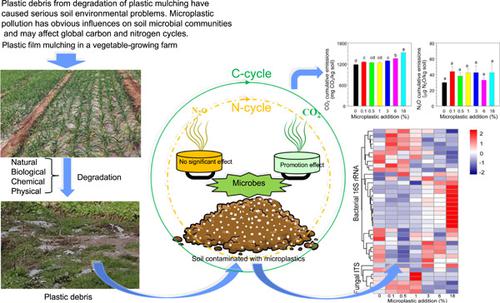当前位置:
X-MOL 学术
›
Environ. Toxicol. Chem.
›
论文详情
Our official English website, www.x-mol.net, welcomes your
feedback! (Note: you will need to create a separate account there.)
Microplastic Addition Alters the Microbial Community Structure and Stimulates Soil Carbon Dioxide Emissions in Vegetable‐Growing Soil
Environmental Toxicology and Chemistry ( IF 3.6 ) Pub Date : 2020-10-26 , DOI: 10.1002/etc.4916 Bo Gao 1, 2, 3 , Huaiying Yao 1, 2, 4 , Yaying Li 1, 2 , Yizu Zhu 1, 2, 3
Environmental Toxicology and Chemistry ( IF 3.6 ) Pub Date : 2020-10-26 , DOI: 10.1002/etc.4916 Bo Gao 1, 2, 3 , Huaiying Yao 1, 2, 4 , Yaying Li 1, 2 , Yizu Zhu 1, 2, 3
Affiliation

|
Microplastic pollution has become an increasingly pervasive issue worldwide, but little is known about its effects on the soil environment. A soil microcosm experiment was conducted using low‐density polyethylene microplastics to estimate the effect of microplastic pollution on soil nutrient cycling and the soil microbial community structure. The results showed that microplastic addition significantly promoted soil carbon dioxide emissions but not soil nitrous oxide emissions. Soil pH, dissolved organic carbon, ammonia nitrogen, the contents of total phospholipid fatty acid (PLFA), and the ratios of gram‐positive bacteria to gram‐negative bacteria and saturated to monounsaturated PLFAs significantly increased. In addition, nitrate nitrogen and the ratios of fungi to bacteria, total iso‐branched fatty acids to total anteiso‐branched fatty acids, and cyclopropyl to precursor significantly decreased with increasing microplastic addition. The addition of microplastics decreased the abundance of ammonia oxidizing bacteria and nitrite reductase (nirS) but had little effect on the functional genes of ammonia oxidizing archaea, nitrite reductase (nirK), and nitrous oxide reductase. A principal coordinate analysis of the bacterial 16S ribosomal RNA gene and fungal internal transcribed spacer in the microplastic addition treatments revealed that the bacterial and fungal communities formed an obvious cluster. The average abundance of some microbial species with tolerance and degradability to microplastics, such as Nocardioidaceae, Amycolatopsis, Aeromicrobium, Cytophagaceae, Betaproteobacteria, Rhodoplanes, and Mortierella, in the microplastic addition treatments was significantly higher than that of the control treatment. The results suggested that microplastics have obvious influences on microbial communities and may affect global carbon and nitrogen cycles. Environ Toxicol Chem 2021;40:352–365. © 2020 SETAC
中文翻译:

添加微塑料改变微生物群落结构并刺激蔬菜种植土壤中的土壤二氧化碳排放
微塑料污染已成为世界范围内日益普遍的问题,但对其对土壤环境的影响知之甚少。使用低密度聚乙烯微塑料进行土壤微观实验,以评估微塑料污染对土壤养分循环和土壤微生物群落结构的影响。结果表明,微塑料的添加显着促进了土壤二氧化碳的排放,但不显着促进土壤氧化亚氮的排放。土壤pH值、溶解有机碳、氨氮、总磷脂脂肪酸(PLFA)含量、革兰氏阳性菌与革兰氏阴性菌、饱和与单不饱和PLFAs的比值均显着增加。此外,硝态氮和真菌与细菌的比例、异支链脂肪酸总量与反异支链脂肪酸总量、随着微塑料添加量的增加,环丙基对前体的影响显着降低。添加微塑料降低了氨氧化细菌和亚硝酸还原酶的丰度。nirS),但对氨氧化古细菌、亚硝酸还原酶(nirK)和一氧化二氮还原酶的功能基因影响不大。对微塑料添加处理中细菌 16S 核糖体 RNA 基因和真菌内部转录间隔区的主要坐标分析表明,细菌和真菌群落形成了明显的集群。一些对微塑料具有耐受性和可降解性的微生物物种的平均丰度,例如诺卡氏菌科、无支枝菌属、空气微生物属、噬菌体科、β变形菌属、红球菌属和被孢霉属, 在微塑料添加处理中显着高于对照处理。结果表明,微塑料对微生物群落有明显影响,并可能影响全球碳氮循环。环境毒理学化学2021;40:352-365。© 2020 SETAC
更新日期:2020-10-26
中文翻译:

添加微塑料改变微生物群落结构并刺激蔬菜种植土壤中的土壤二氧化碳排放
微塑料污染已成为世界范围内日益普遍的问题,但对其对土壤环境的影响知之甚少。使用低密度聚乙烯微塑料进行土壤微观实验,以评估微塑料污染对土壤养分循环和土壤微生物群落结构的影响。结果表明,微塑料的添加显着促进了土壤二氧化碳的排放,但不显着促进土壤氧化亚氮的排放。土壤pH值、溶解有机碳、氨氮、总磷脂脂肪酸(PLFA)含量、革兰氏阳性菌与革兰氏阴性菌、饱和与单不饱和PLFAs的比值均显着增加。此外,硝态氮和真菌与细菌的比例、异支链脂肪酸总量与反异支链脂肪酸总量、随着微塑料添加量的增加,环丙基对前体的影响显着降低。添加微塑料降低了氨氧化细菌和亚硝酸还原酶的丰度。nirS),但对氨氧化古细菌、亚硝酸还原酶(nirK)和一氧化二氮还原酶的功能基因影响不大。对微塑料添加处理中细菌 16S 核糖体 RNA 基因和真菌内部转录间隔区的主要坐标分析表明,细菌和真菌群落形成了明显的集群。一些对微塑料具有耐受性和可降解性的微生物物种的平均丰度,例如诺卡氏菌科、无支枝菌属、空气微生物属、噬菌体科、β变形菌属、红球菌属和被孢霉属, 在微塑料添加处理中显着高于对照处理。结果表明,微塑料对微生物群落有明显影响,并可能影响全球碳氮循环。环境毒理学化学2021;40:352-365。© 2020 SETAC











































 京公网安备 11010802027423号
京公网安备 11010802027423号